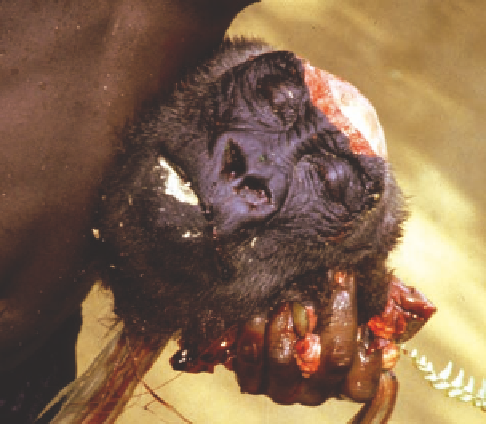Environmental Engineering Reference
In-Depth Information
In 1950, an estimated 100,000 tigers existed in the
world. Despite international protection, fewer than
7,500 tigers now remain in the wild, about 4,000 of
them in India. Bengal tigers are at risk because a tiger
fur sells for $100,000 in Tokyo. With the body parts of
a single tiger worth $5,000-20,000, it is not surprising
that illegal hunting has skyrocketed, especially in
India. Without emergency action to curtail poaching
and preserve their habitat, few if any tigers may be left
in the wild within 20 years.
As commercially valuable species become endan-
gered, their black market demand soars. This increases
their chances of premature extinction from poaching.
For poachers, the money they can make far outweighs
the small risk of being caught, fined, and imprisoned.
bushmeat trade is also increasing in Southeast Asia,
the Caribbean, and Central and South America.
So what is the big deal? After all, people have to
eat. For most of our existence, humans have survived
by hunting and gathering wild species.
The problem is that bushmeat hunting has caused
the local extinction of many animals in parts of West
Africa and has driven one species—Miss Waldron's red
colobus monkey—to complete extinction. It is also a
factor in greatly reducing gorilla, orangutan (Figure 8-4,
p. 157), and chimpanzee populations.
This practice also threatens forest carnivores such
as crowned eagles and leopards by depleting their
main prey species. The forest itself is changed because
of the decrease in seed-dispersing animals—those con-
nections again.
Economics Case Study: The Rising Demand
for Bushmeat in Africa
Rapid population growth in parts of Africa has
increased the number of people hunting wild
animals for food or for sale of their meat to
restaurants.
Indigenous people in much of West and Central Africa
have sustainably hunted wildlife for
bushmeat,
a source
of food, for centuries. But in the last two decades bush-
meat hunting in some areas has skyrocketed as local
people try to provide food for a rapidly growing popu-
lation and to supply restaurants (Figure 9-15). The
Economics and Ethics: Killing Predators
and Pest Control
Killing predators that bother us or cause economic
losses threatens some species with premature
extinction.
People often try to exterminate species that compete
with them for food and game animals. For example,
African farmers kill large numbers of elephants to
keep them from trampling and eating food crops. Each
year, U.S. government animal control agents shoot,
poison, or trap thousands of coyotes, prairie dogs,
wolves, bobcats, and other species that prey on live-
stock, on species prized by game hunters, on crops, or
on fish raised in aquaculture ponds.
Since 1929, U.S. ranchers and government agen-
cies have poisoned 99% of North America's prairie
dogs (Figure 9-3) because horses and cattle sometimes
step into the burrows and break their legs. This prac-
tice has also nearly wiped out the endangered black-
footed ferret (Figure 9-3; about 600 left in the wild),
which preyed on the prairie dog.
Economics and Ethics: Exotic Pets
and Decorative Plants
Legal and illegal trade in wildlife species used as pets
or for decorative purposes threatens some species
with extinction.
The global legal and illegal trade in wild species for
use as pets is a huge and very profitable business.
However, for every live animal captured and sold in
the pet market, an estimated 50 others are killed.
About 25 million U.S. households have exotic
birds as pets, 85% of them imported. More than 60 bird
species, mostly parrots, (Figure 8-5, p. 157), are endan-
gered or threatened because of this wild bird trade. Ac-
cording to the U.S. Fish and Wildlife Service, collectors
of exotic birds may pay $10,000 for a threatened hy-
Figure 9-15
Natural capital degradation:
Bushmeat,
such as
this severed head of a lowland gorilla in the Congo, is con-
sumed as a source of protein by local people in parts of West
Africa and sold in the national and international marketplace.
You can find bushmeat on the menu in Cameroon and the
Congo in West Africa as well as in Paris, France, and Brussels,
Belgium. It is often supplied by illegal poaching. Wealthy pa-
trons of some restaurants regard gorilla meat as a source of
status and power.


